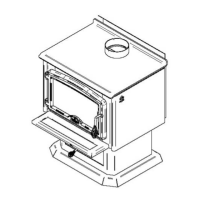Page 42
Installation and Operation Manual - 2000
ENGLISH
8.4.2 Why the Chimney Should Penetrate the Highest Heated Space
When it is cold outside, the warm air in the house is buoyant so it tends to rise. This tendency
of warm air to rise creates a slight pressure difference in the house. Called ‘stack effect’, it
produces a slightly negative pressure low in the house (relative to outside) and a slightly positive
pressure zone high in the house. If there is no fire burning in a heater connected to a chimney
that is shorter than the warm space inside the house, the slight negative pressure low in the
house will compete against the desired upward flow in the chimney.
There are two reasons why the
chimney in the house at right will cold
backdraft when it is cold outside and
there is no fire burning in the stove.
First, the chimney runs up the outside
of the house, so the air in it is colder
and denser than the warm air in the
house. And second, the chimney is
shorter than the heated space of the
house, meaning the negative pressure
low in the house will pull outside
air down the chimney, through the
stove and into the room. Even the
finest stove will not work well when
connected to this chimney.
Figure 32: Chimney location in the house
8.5 Supply of Combustion Air
In Canada, wood stoves are not required to have a supply of combustion air from outdoors because
research has shown that these supplies do not give protection against house depressurization
and may fail to supply combustion air during windy weather. However, to protect against the
risk of smoke spillage due to house depressurization, a carbon monoxide (CO) detector/alarm is
required in the room in which the stove is installed. The CO detector will provide warning if for
any reason the wood stove fails to function correctly.
8.5.1 Combustion Air Supply in Mobile Homes
Only a wood stove certified and labelled as ‘mobile home approved’ may be installed in a mobile
home. This Osburn 2000 stove is ‘mobile home approved’. Wood stoves installed in mobile
homes must have a ducted supply of combustion air from outdoors. This air supply should be
routed down through the house floor into the vented crawl space under the mobile home. The
air supply duct should be non-combustible aluminum flex duct with a screened weatherhood on
the outside end.
Note: Fabric duct may also be used, provided it is suitable for HVAC use and meets the
requirements of ULC-S110 or UL-181 Class 1 standards. It must have a non-combustible
insulation and be corrosion resistant.
Where a mobile home has been converted to a standard house by mounting it on a permanent
basement foundation, the supply of outdoor air is not required.

